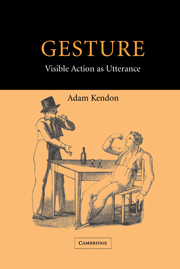Book contents
- Frontmatter
- Contents
- Acknowledgments
- 1 The domain of gesture
- 2 Visible action as gesture
- 3 Western interest in gesture from Classical Antiquity to the eighteenth century
- 4 Four contributions from the nineteenth century: Andrea de Jorio, Edward Tylor, Garrick Mallery and Wilhelm Wundt
- 5 Gesture studies in the twentieth century: recession and return
- 6 Classifying gestures
- 7 Gesture units, gesture phrases and speech
- 8 Deployments of gesture in the utterance
- 9 Gesture and speech in semantic interaction
- 10 Gesture and referential meaning
- 11 On pointing
- 12 Gestures of ‘precision grip’: topic, comment and question markers
- 13 Two gesture families of the open hand
- 14 Gesture without speech: the emergence of kinesic codes
- 15 ‘Gesture’ and ‘sign’ on common ground
- 16 Gesture, culture and the communication economy
- 17 The status of gesture
- Appendix I Transcription conventions
- Appendix II The recordings
- References
- Index
14 - Gesture without speech: the emergence of kinesic codes
Published online by Cambridge University Press: 05 February 2015
- Frontmatter
- Contents
- Acknowledgments
- 1 The domain of gesture
- 2 Visible action as gesture
- 3 Western interest in gesture from Classical Antiquity to the eighteenth century
- 4 Four contributions from the nineteenth century: Andrea de Jorio, Edward Tylor, Garrick Mallery and Wilhelm Wundt
- 5 Gesture studies in the twentieth century: recession and return
- 6 Classifying gestures
- 7 Gesture units, gesture phrases and speech
- 8 Deployments of gesture in the utterance
- 9 Gesture and speech in semantic interaction
- 10 Gesture and referential meaning
- 11 On pointing
- 12 Gestures of ‘precision grip’: topic, comment and question markers
- 13 Two gesture families of the open hand
- 14 Gesture without speech: the emergence of kinesic codes
- 15 ‘Gesture’ and ‘sign’ on common ground
- 16 Gesture, culture and the communication economy
- 17 The status of gesture
- Appendix I Transcription conventions
- Appendix II The recordings
- References
- Index
Summary
We turn now to a consideration of gesture when it is used as the sole means of utterance. This occurs in a wide range of circumstances, whenever, for whatever reason, speech cannot be used. Depending upon the nature of these circumstances, a more or less well established kinesic code may come to be elaborated. In some cases such a code becomes sufficiently non-specialized in its use and sufficiently well established as a social institution for it to merit the term ‘language’. Languages fashioned exclusively from the kinesic medium are generally termed ‘sign languages’.
It is useful to distinguish between primary sign languages and alternate sign languages. Primary sign languages are sign languages that develop in communities of deaf people. These may have, at best, only an indirect relationship with the spoken language or languages in use in the society within which the deaf community in question is found. Alternate sign languages, on the other hand, are those highly elaborate kinesic codes that are found in some speaker-hearer communities, such as certain groups among the Aborigines of Australia or among the Plains Indians of North America. Here the relationship between the sign language and the spoken languages in use may be direct and, in some cases, the structure of the sign language may even constitute a kinesic representation of aspects of spoken language structure. Alternate sign languages will be discussed in a later section of this chapter. See also Kendon (1988b).
- Type
- Chapter
- Information
- GestureVisible Action as Utterance, pp. 284 - 306Publisher: Cambridge University PressPrint publication year: 2004



